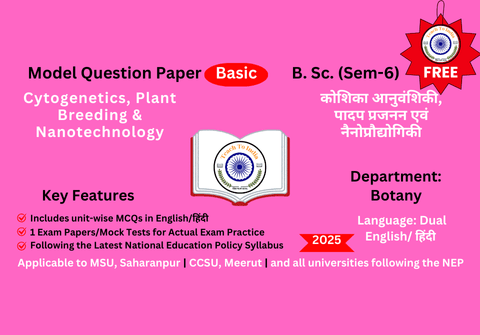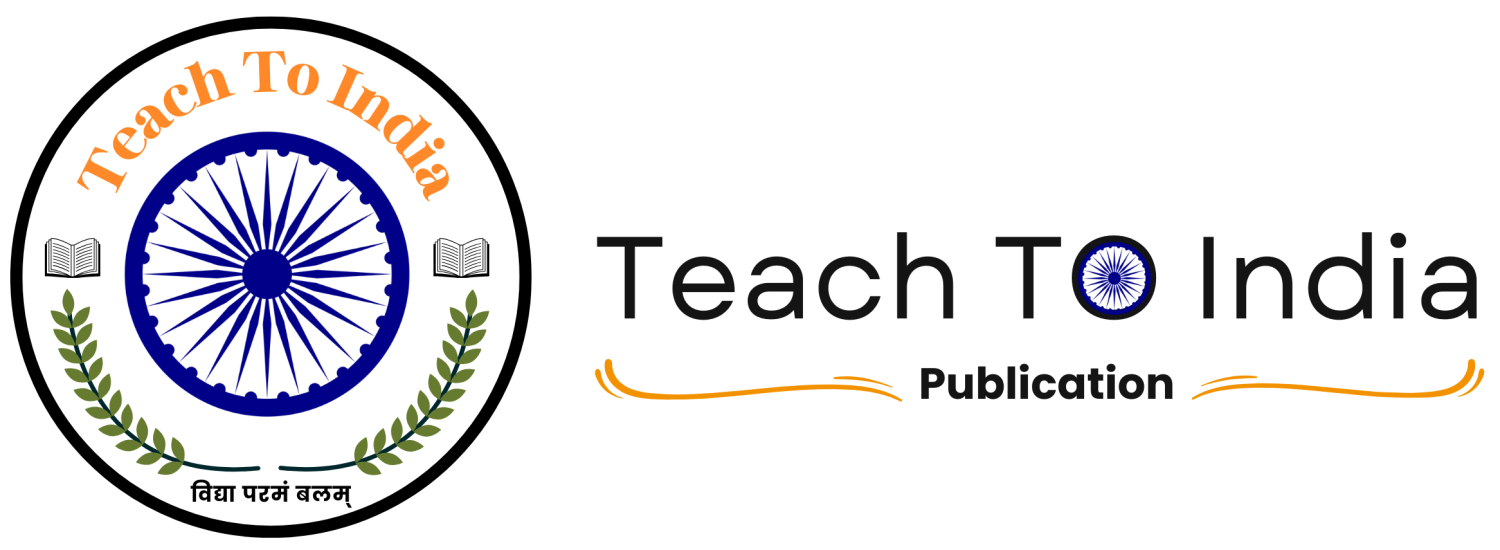Cytogenetics, Plant Breeding And Nanotechnology - कोशिका आनुवंशिकी, पादप प्रजनन एवं नैनोप्रौद्योगिकी
- Description
- Curriculum
- Reviews

Model Question Paper
Cytogenetics, Plant Breeding & Nanotechnology – कोशिका आनुवंशिकी, पादप प्रजनन एवं नैनोप्रौद्योगिकी
Key Features | मुख्य विशेषताएँ
- Bilingual Model Paper | द्विभाषी मॉडल पेपर
- Enough MCQ for Practice | अभ्यास के लिए पर्याप्त MCQ
- Exam Practice Paper with Mock Tests | मॉक टेस्ट के साथ परीक्षा अभ्यास पत्र
- Latest Syllabus as per NEP | NEP के अनुसार नवीनतम पाठ्यक्रम
- Designed by Experts | विशेषज्ञों द्वारा तैयार किया गया
The given MCQs cover only 10% of the syllabus | दिए गए बहुविकल्पीय प्रश्न केवल 10% पाठ्यक्रम को कवर करते हैं।
To cover 100% of the syllabus with summaries, upgrade to our Advanced Model Paper.| पूरा सिलेबस और सारांश कवर करने के लिए हमारा एडवांस मॉडल पेपर जॉइन करें। Join Advanced Model Paper
|
Program/Class: Degree/ B.Sc. |
Year: Third |
Semester: Sixth |
||
|
Subject: Botany |
||||
|
Course Title: Cytogenetics, Plant Breeding & Nanotechnology |
||||
|
Course Outcome: After the completion of the course the students will be able to: 1. Acquire knowledge on cell ultrastructure. 2. Understand the structure and chemical composition of chromatin and concept of cell division. 3. Interpret the Mendel ‘s principles, acquire knowledge on cytoplasmic inheritance and sex-linked inheritance. 4. Understand the concept of ‗one gene one enzyme hypothesis‘along with the molecular mechanism of mutation. |
||||
|
Credits: 4 |
Core Compulsory |
|||
|
Max. Marks: 25+75 |
Min. Passing Marks: 33 |
|||
|
Unit |
Topics |
|||
|
I |
Cell biology Structure and function of cell wall, plasma membrane, ribosomes, Endoplasmic reticulum, golgi apparatus, mitochondria, chloroplast, lysosomes, peroxisomes and cell inclusions – Organization of nucleus: nuclear envelope, nucleoplasm and nucleolus. Chromosomal nomenclature- chromatids, centromere, telomere, satellite, secondary constriction. Organization of chromosomes- Nucleic acid and histones- types and classification. Lampbrush chromosomes and polytene chromosomes- Karyotype and idiogram.Cell cycle:– mitosis: open and closed mitosis – amitosis – meiosis. Variation in Chromosome number (Numerical aberrations)- aneuploidy and Euploidy-haploidy, polyploidy- significance (Structural aberrations) – deletion, duplication, inversion and translocation.
|
|||
|
II |
Genetics Chromosome theory of inheritance, crossing over and linkage; Incomplete dominance and codominance; Interaction of Genes; Multiple alleles, Lethal alleles, Epistasis, Pleiotropy, Polygenic inheritance; Extra-nuclear Inheritance, Linkage, crossing over, Concept of sex determination and Sex chromosomes; Patterns of Sex determination in plants
|
|||
|
III |
Plant breeding Plant introduction. Agencies of plant introduction in India, Procedure of introduction – Acclimatization – Achievements, Selection – mass selection, pure line selection and clonal selection. Genetic basis of selection methods, Hybridization: Procedure of hybridization, inter generic, inter specific, inter varietal hybridization with examples. Composite and synthetic varieties, Male sterility, Heterosis and its exploitation in plant breeding, Mutation, Molecular Breeding (use of DNA markers in plant breeding), achievements in India, Breeding for pest, pathogenic diseases and stress resistance
|
|||
|
IV |
Biostatistics: Definition, statistical methods, basic principles, variables- measurements, functions, limitations and uses of statistics. Biometry: Data, Sample, Population, random sampling, Frequency distribution- definition only, Central tendency– Arithmetic Mean, Mode and Median; Measurement of dispersion–Coefficient of variation, Standard Deviation, Standard error of Mean; Test of significance: chi- square test for goodness of fit. Computer application in biostatistics – MS Excel and SPSS
|
|||
|
V |
Plant tissue culture Elementary knowledge of Principles, components and techniques of in vitro plant cultures, Callus cultures, Cell culture, cell suspension cultures, Embryogenesis and organogenesis, Protoplast isolation and culturing of protoplast- principle and application, regeneration of protoplasts, protoplast fusion and somatic hybridization- selection of hybrid cells, Somaclonal variation, Plant secondary metabolites production
|
|||
|
VI |
Nanotechnology Nanoscale assembly of cellular components (cell membrane and liposomes). Nanoscale assembly of microorganisms (virus). Nano-particle synthesis: Biological synthesis of Nanoparticles, Advantages and applications of biologically synthesized nanomaterials. Introduction to biological nanomaterials. Biomineralization, Magnetosomes, nano-pesticides, nano-fertilizers, nano-sensors
|
|||
|
VII |
Artificial Intelligence in Plant Sciences Elementary idea of Big Data Analytics, Blockchain Technology, 3-D Printing, Machine learning, Algorithms of Machine Learning, Expert systems and Fuzzy logic, Artificial Neural Networks and Genetic algorithms, Predictive Analytics, Agents and Robotics, IoT Sensors, Object Image capture & analysis; Applications of Artificial Neural Networks in Plant Science
|
|||
|
VIII |
Introduction to use of Digital technologies – AI, IoT & ICT in Botany Educational software- INFLIBNET, NICNET, BRNET, internet as a knowledge repository- google scholar, science direct. resource management, weather forecasting. IoT Database management, IoT platforms, IoT Graphical user interface • IoT application development for Android Mobile phones, ICT Applications for different crops and horticulture
|
|||
-
1Unit 1: MCQs - Cytogenetics, Plant Breeding & Nanotechnology
-
2Unit 2: MCQs - Cytogenetics, Plant Breeding & Nanotechnology
-
3Unit 3: MCQs - Cytogenetics, Plant Breeding & Nanotechnology
-
4Unit 4: MCQs - Cytogenetics, Plant Breeding & Nanotechnology
-
5Unit 5: MCQs - Cytogenetics, Plant Breeding & Nanotechnology
-
6Unit 6: MCQs - Cytogenetics, Plant Breeding & Nanotechnology
-
7Unit 7: MCQs - Cytogenetics, Plant Breeding & Nanotechnology
-
8Unit 8: MCQs - Cytogenetics, Plant Breeding & Nanotechnology







